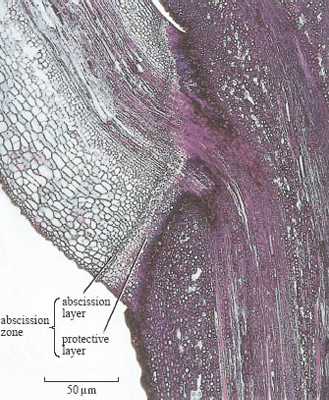1.4 Strategy 2: dormancy in winter ('opt out')
1.4.1 Deciduous trees
During the winter months, a combination of factors, including lower temperatures, reduced light intensity and shorter days, means that plants can only photosynthesise at a slow rate and for restricted periods. As a result, photosynthesis cannot produce energy as fast as respiration expends it. In addition, water is often in short supply because of freezing, and so plants that do not have adaptations to conserve water, as conifers do, would lose water. Deciduous trees avoid these problems in winter by dropping all their leaves and shutting off photosynthesis. Before they do so, they dismantle the photosynthetic apparatus in their leaves and withdraw many of the constituents to their branches, trunks and roots.
Thus, in the autumn, sugars, amino acids and such minerals as nitrogen, phosphorus and potassium are transported from the leaves to woody tissues. Chlorophyll is broken down and the products are also withdrawn from the leaves. It is this process that causes leaves to change colour in the autumn. The breakdown of chlorophyll leaves behind other pigments, such as orange carotenes and yellow xanthophylls, which are normally hidden by the green chlorophyll. Once as many nutrients as possible have been withdrawn from a leaf, an abscission zone forms where the leaf stalk (petiole) meets the stem (Figure 12). Here the vessels that supply water and nutrients to the leaf are closed off and the leaf detaches, leaving a protective covering of cork over the scar. Leaf abscission is controlled by a complex system of hormones, responding to lower temperatures and light intensity and to shorter day length.

